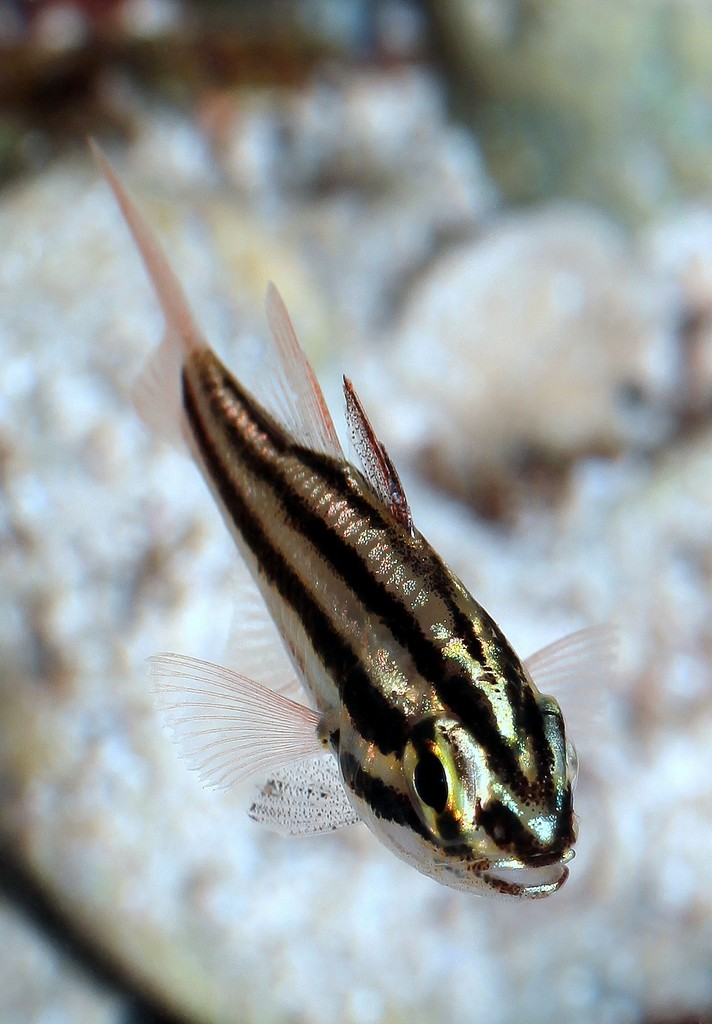OSTORHINCHUS TAENIOPHORUS - (REGAN, 1908)
Actinopterygii (Gigaclass) > Actinopteri (Class) > Teleostei (Subclass) > Gobiiformes (Order) > Apogonoidei (Suborder) > Apogonidae (Family) > Apogoninae (Subfamily) > Ostorhinchus (Genus)
Apogon de platier, Ninestripe cardinal, Pearly-line cardinalfish, Pearly-lined cardinal, Pearly-lined cardinalfish, Reef-flat cardinalfish, Negestreep-kardinaal, Misuji-tenjikudai, ミスジテンジクダイ, 大面侧仔, 褐带天竺鲷,
Synonymes
Amia fasciata stevensi (McCulloch, 1915)
Apogon saipanensis (Fowler, 1945)
Apogon taeniophorus (Regan, 1908)
Lovamia saipanensis (Fowler, 1945)
---------------------------
Description
Dorsal spines (total): 8; Dorsal soft rays (total): 9; Anal spines: 2; Anal soft rays: 8; Pectoral fin rays: 14; Pelvic fin rays: I, 5; Pored lateral line scales: 24; Predorsal scales: 3-4; Circumpeduncular scales: 12; Body depth: 2.7-3.0 in SL. Max. length: 11.5 cm TL. Depth range: 0 - 15 m.
Color
Whitish body with 5-6 black stripes along the side, a short narrow dark stripe behind the upper part of the eye to below the dorsal fin, and no distinct spot on the tail base.
Etymology
Ostorhinchus: from Greek, osteon = bone + from Greek, rhynchos = beak. In reference to the bony jaws, very much advanced and jagged, which take the place of the teeth.
taeniophorus: from Greek, taeni-, taenio = ribbon, band, stripe, tapeworm + from Greek, phoros = bearer of, thing or part bearing. Referring to four dark longitudinal stripes on sides.
Original description: Apogon taeniophorus Regan, 1908 - Type locality: Maldives, western Indian Ocean.
Distribution
Indo-West Pacific: East Africa, South Africa, Madagascar and Mascarenes east to Kiribati (Line Islands) and Pitcairn Group, north to southern Japan and Ogasawara Islands, south to Western Australia, New South Wales (Australia), New Caledonia and Rapa.
Biology
Occurs inshore. Found in holes or ledges of outer reef flats in areas exposed to surge. Nocturnal. Mouthbrooders. Distinct pairing during courtship and spawning.
Similar species
Apogon de platier, Ninestripe cardinal, Pearly-line cardinalfish, Pearly-lined cardinal, Pearly-lined cardinalfish, Reef-flat cardinalfish, Negestreep-kardinaal, Misuji-tenjikudai, ミスジテンジクダイ, 大面侧仔, 褐带天竺鲷,
Synonymes
Amia fasciata stevensi (McCulloch, 1915)
Apogon saipanensis (Fowler, 1945)
Apogon taeniophorus (Regan, 1908)
Lovamia saipanensis (Fowler, 1945)
---------------------------
Description
Dorsal spines (total): 8; Dorsal soft rays (total): 9; Anal spines: 2; Anal soft rays: 8; Pectoral fin rays: 14; Pelvic fin rays: I, 5; Pored lateral line scales: 24; Predorsal scales: 3-4; Circumpeduncular scales: 12; Body depth: 2.7-3.0 in SL. Max. length: 11.5 cm TL. Depth range: 0 - 15 m.
Color
Whitish body with 5-6 black stripes along the side, a short narrow dark stripe behind the upper part of the eye to below the dorsal fin, and no distinct spot on the tail base.
Etymology
Ostorhinchus: from Greek, osteon = bone + from Greek, rhynchos = beak. In reference to the bony jaws, very much advanced and jagged, which take the place of the teeth.
taeniophorus: from Greek, taeni-, taenio = ribbon, band, stripe, tapeworm + from Greek, phoros = bearer of, thing or part bearing. Referring to four dark longitudinal stripes on sides.
Original description: Apogon taeniophorus Regan, 1908 - Type locality: Maldives, western Indian Ocean.
Distribution
Indo-West Pacific: East Africa, South Africa, Madagascar and Mascarenes east to Kiribati (Line Islands) and Pitcairn Group, north to southern Japan and Ogasawara Islands, south to Western Australia, New South Wales (Australia), New Caledonia and Rapa.
Biology
Occurs inshore. Found in holes or ledges of outer reef flats in areas exposed to surge. Nocturnal. Mouthbrooders. Distinct pairing during courtship and spawning.
Similar species
- Ostorhinchus angustatus (Smith & Radcliffe, 1911) - Reported from New Caledonia - Link to the species (here) - Body white colored, with five poorly defined dark brown stripes on lateral surface of body, posterior end of third stripe reaching black spot on base of caudal fin; Base of caudal fin with spot subequal in size to pupil.
- Ostorhinchus cookii (MacLeay, 1881) - Reported from New Caledonia - Link to the species (here) - Whitish with 5-6 stripes (dark brown to yellowish), the stripe originating at the upper rear corner of eye incomplete; Midlateral stripe ending in a distinct black spot at caudal fin base. Further characterized by presence of dark spot at middle of caudal fin base merged with midlateral stripe.
- Ostorhinchus nigrofasciatus (Lachner, 1953) - Reported from New Caledonia - Link to the species (here) - Differs in having 15-19 developed gill rakers (10 on ceratobranchial), usually 14 pectoral-fin rays, and no postocular stripe.
- Ostorhinchus victoriae (Günther, 1859) - Reported from Eastern Indian Ocean: Rottnest Island (Western Australia) north to Northern Territory (Australia).
Last update: 23, October 2022
